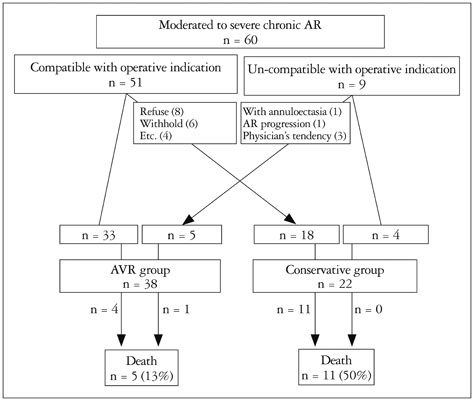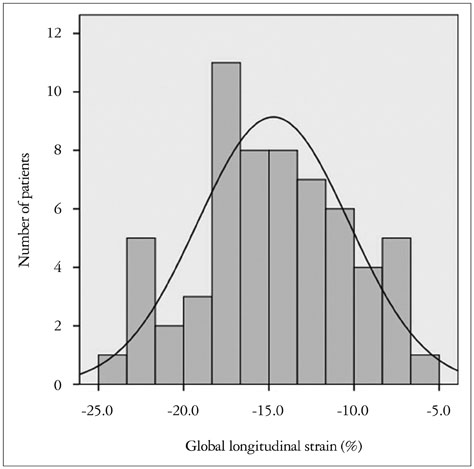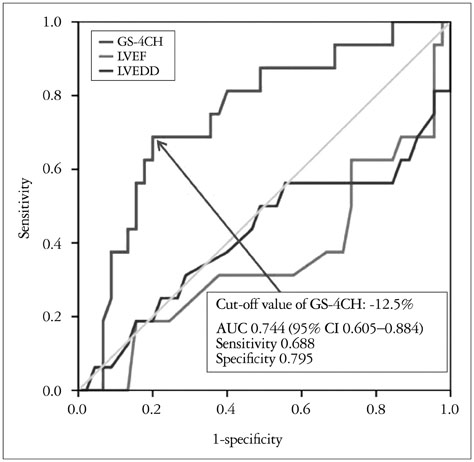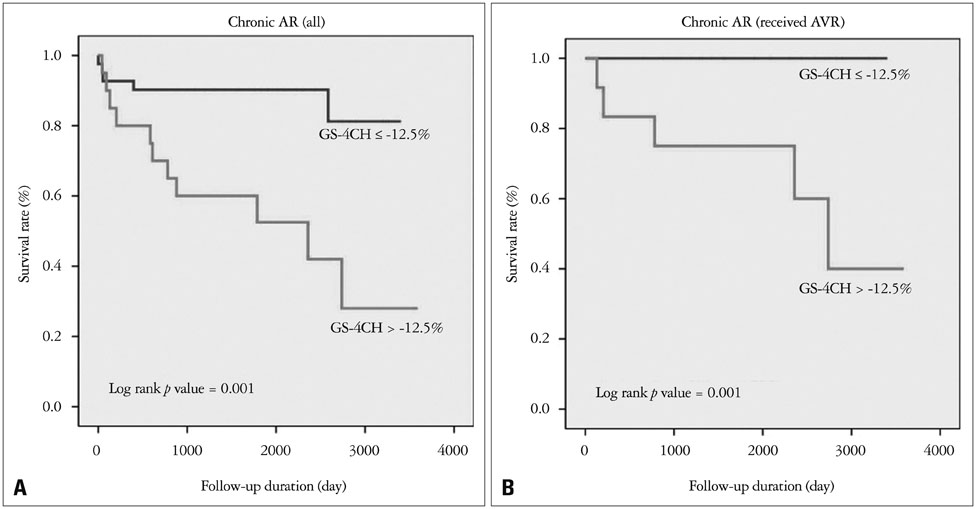J Cardiovasc Ultrasound.
2015 Jun;23(2):78-85. 10.4250/jcu.2015.23.2.78.
Left Ventricular Strain as Predictor of Chronic Aortic Regurgitation
- Affiliations
-
- 1Division of Cardiology, Department of Internal Medicine, Kyungpook National University Hospital, Daegu, Korea. ddhyang@knu.ac.kr
- KMID: 1806915
- DOI: http://doi.org/10.4250/jcu.2015.23.2.78
Abstract
- BACKGROUND
It is not well known about the implication of left ventricular (LV) strain as a predictor for mortality in patients with chronic aortic regurgitation (AR). The purpose of this study was to investigate whether global longitudinal strain measured by two-dimensional speckle-tracking echocardiography could predict long-term outcome in patients with chronic AR.
METHODS
This is a single center non-randomized retrospective observational study. The patients with chronic AR from January 2002 to December 2012 were retrospectively enrolled. Following patients were excluded; combined other significant valvular disease, previous heart surgery, aortic disease, congenital heart disease, acute AR and young age under 18 years old. Finally, 60 patients were analyzed and the LV global strain rate was measured on apical four chamber image (GS-4CH).
RESULTS
During 64 months follow-up duration, 16 patients (26.7%) were deceased and 38 patients (63.3%) underwent aortic valve replacement (AVR). Deceased group was older (69 years old vs. 51 years old, p < 0.001) and had lower longitudinal strain (-12.05 +/- 3.72% vs. -15.66 +/- 4.35%, p = 0.005). Kaplan-Meier survival curve stratified by GS-4CH showed a trend of different event rate (log rank p = 0.001). On multivariate analysis by cox proportional hazard model adjusting for age, sex, body surface area, history of atrial fibrillation, blood urea nitrogen, LV dilatation, LV ejection fraction and AVR, decreased GS-4CH proved to be an independent predictor of mortality in patients with chronic AR (hazard ratio 1.313, 95% confidence interval 1.010-1.706, p = 0.042).
CONCLUSION
GS-4CH may be a useful predictor of mortality in patient with chronic AR.
MeSH Terms
Figure
Reference
-
1. Iida N, Seo Y, Ishizu T, Nakajima H, Atsumi A, Yamamoto M, Machino-Ohtsuka T, Kawamura R, Enomoto M, Kawakami Y, Aonuma K. Transmural compensation of myocardial deformation to preserve left ventricular ejection performance in chronic aortic regurgitation. J Am Soc Echocardiogr. 2012; 25:620–628.2. Bonow RO, Carabello BA, Chatterjee K, de Leon AC Jr, Faxon DP, Freed MD, Gaasch WH, Lytle BW, Nishimura RA, O'Gara PT, O'Rourke RA, Otto CM, Shah PM, Shanewise JS. American College of Cardiology/American Heart Association Task Force on Practice Guidelines. 2008 focused update incorporated into the ACC/AHA 2006 guidelines for the management of patients with valvular heart disease: a report of the American College of Cardiology/American Heart Association Task Force on Practice Guidelines (Writing Committee to revise the 1998 guidelines for the management of patients with valvular heart disease). Endorsed by the Society of Cardiovascular Anesthesiologists, Society for Cardiovascular Angiography and Interventions, and Society of Thoracic Surgeons. J Am Coll Cardiol. 2008; 52:e1–e142.3. Ekery DL, Davidoff R. Aortic regurgitation: quantitative methods by echocardiography. Echocardiography. 2000; 17:293–302.4. The Korean Society of Echocardiography. The Text Book of Clinical Echocardiography. 3rd ed. Seoul: Daehan Medical Books;2013. p. 329–333.5. Detaint D, Messika-Zeitoun D, Maalouf J, Tribouilloy C, Mahoney DW, Tajik AJ, Enriquez-Sarano M. Quantitative echocardiographic determinants of clinical outcome in asymptomatic patients with aortic regurgitation: a prospective study. JACC Cardiovasc Imaging. 2008; 1:1–11.6. American College of Cardiology/American Heart Association Task Force on Practice Guidelines. Society of Cardiovascular Anesthesiologists. Society for Cardiovascular Angiography and Interventions. Society of Thoracic Surgeons. Bonow RO, Carabello BA, Kanu C, de Leon AC Jr, Faxon DP, Freed MD, Gaasch WH, Lytle BW, Nishimura RA, O'Gara PT, O'Rourke RA, Otto CM, Shah PM, Shanewise JS, Smith SC Jr, Jacobs AK, Adams CD, Anderson JL, Antman EM, Faxon DP, Fuster V, Halperin JL, Hiratzka LF, Hunt SA, Lytle BW, Nishimura R, Page RL, Riegel B. ACC/AHA 2006 guidelines for the management of patients with valvular heart disease: a report of the American College of Cardiology/American Heart Association Task Force on Practice Guidelines (writing committee to revise the 1998 Guidelines for the Management of Patients With Valvular Heart Disease): developed in collaboration with the Society of Cardiovascular Anesthesiologists: endorsed by the Society for Cardiovascular Angiography and Interventions and the Society of Thoracic Surgeons. Circulation. 2006; 114:e84–e231.7. Tornos MP, Olona M, Permanyer-Miralda G, Herrejon MP, Camprecios M, Evangelista A, Garcia del Castillo H, Candell J, Soler-Soler J. Clinical outcome of severe asymptomatic chronic aortic regurgitation: a long-term prospective follow-up study. Am Heart J. 1995; 130:333–339.8. Onishi T, Kawai H, Tatsumi K, Kataoka T, Sugiyama D, Tanaka H, Okita Y, Hirata K. Preoperative systolic strain rate predicts postoperative left ventricular dysfunction in patients with chronic aortic regurgitation. Circ Cardiovasc Imaging. 2010; 3:134–141.9. Chaliki HP, Mohty D, Avierinos JF, Scott CG, Schaff HV, Tajik AJ, Enriquez-Sarano M. Outcomes after aortic valve replacement in patients with severe aortic regurgitation and markedly reduced left ventricular function. Circulation. 2002; 106:2687–2693.10. Edvardsen T, Gerber BL, Garot J, Bluemke DA, Lima JA, Smiseth OA. Quantitative assessment of intrinsic regional myocardial deformation by Doppler strain rate echocardiography in humans: validation against three-dimensional tagged magnetic resonance imaging. Circulation. 2002; 106:50–56.11. Yu CM, Sanderson JE, Marwick TH, Oh JK. Tissue Doppler imaging a new prognosticator for cardiovascular diseases. J Am Coll Cardiol. 2007; 49:1903–1914.12. Marciniak A, Sutherland GR, Marciniak M, Claus P, Bijnens B, Jahangiri M. Myocardial deformation abnormalities in patients with aortic regurgitation: a strain rate imaging study. Eur J Echocardiogr. 2009; 10:112–119.13. Di Salvo G, Rea A, Mormile A, Limongelli G, D'Andrea A, Pergola V, Pacileo G, Caso P, Calabrò R, Russo MG. Usefulness of bidimensional strain imaging for predicting outcome in asymptomatic patients aged ≤ 16 years with isolated moderate to severe aortic regurgitation. Am J Cardiol. 2012; 110:1051–1055.14. Olsen NT, Sogaard P, Larsson HB, Goetze JP, Jons C, Mogelvang R, Nielsen OW, Fritz-Hansen T. Speckle-tracking echocardiography for predicting outcome in chronic aortic regurgitation during conservative management and after surgery. JACC Cardiovasc Imaging. 2011; 4:223–230.
- Full Text Links
- Actions
-
Cited
- CITED
-
- Close
- Share
- Similar articles
-
- Reduced Longitudinal Function in Chronic Aortic Regurgitation
- Regional impairment of left ventricular longitudinal strain in aortic regurgitation
- Comparison of Postoperative LV Function after Mitral Valve Replacement and Predictor of Postoperative LV Function in Chronic Mitral Regurgitation
- Hemodynamic Study of Subpulmonic Ventricular Defect(by Cardiac Catheterization and Cineangiocardiography)
- Systolic Time Intervals in Valvular Heart Disease





